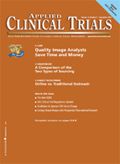Crisis Squeezes Clinical Trials Regulation
The NICE will possess greater power, scope, and status under the new system.
Plenty of clinical trial departments in Europe are already feeling the pinch as the economic crisis bites ever deeper. Independent investigators are also finding it harder to access grants as funding gets tighter from charitable foundations. But now the knock-on effects of the credit crunch are being felt in regulatory agencies too—and not just in the smaller countries. Sweeping changes have just been announced in what until now has been one of Europe's pioneer countries for clinical trials—the United Kingdom.

Peter O'Donnell
The British regulatory system for clinical trials—and indeed for research into medicines generally— is to be rejigged, as part of the new UK government's austerity plans to bring down government spending. Bureaucracy will be cut by streamlining the functions of several key advisory organizations to the health services, and by closing others, UK Health Secretary Andrew Lansley announced in late July. "Over the years the sector has grown to the point where overlap between organizations and duplication of effort have produced a needless bureaucratic web," he argued. The changes are predicted by the government to deliver savings of over $279.5 million USD by 2014/2015. The government announcement stresses the "economic imperative for change," in order to meet 'the current financial challenges and the future costs of demographic and technological change." Over the next four years, administrative costs will be brought down by more than 45 percent, it boasts. No estimate has been made of what the costs might be for those conducting clinical trials.
An expanded NICE
The future is assured for the National Institute for Health and Clinical Excellence, which has become notorious for its often controversial rulings on which medicines may be prescribed through the national health system—fatally frustrating at the commercial stage years of success in scientific development of a new product. Indeed it will be given even greater status and power, and its scope will be expanded.
The Medicines and Health Care Products Regulatory Agency will be retained—"but with the expectation that it will undertake its regulatory duties in the most cost effective way." This bold and bald condition is not, at present, further explained, but is likely to inspire some caution among those who have already experienced difficulties and delays in obtaining, for instance, clinical trial authorizations.
The Health and Social Care Information Center, which collects and provides health and social care information, will be retained, with a clearer focus on data collection. And the Blood and Transplant agency that provides blood, organs, and associated services to the national health service will also be retained, although it is to be made "more commercially effective."
But it is the end of the road for the National Patient Safety Agency, which promotes patient safety and manages the National Clinical Assessment Service, the National Research Ethics Service, and confidential enquiries. The National Research Ethics Service helps protect the interests of patients and research participants in clinical trials and facilitates and promotes ethical research. Its tasks include recognizing and authorizing the Research Ethics Committees that approve individual research applications. The Institute for Innovation and Improvement, which supports the national health service by spreading new ways of working, technology, and leadership, will also be closed down.
Similarly, the Human Fertilization and Embryology Authority, which regulate human embryo storage, research, and assisted reproduction treatment, is to be phased out over the next four years. So too is the Human Tissue Authority, which regulates the removal, storage, and use of human tissue and organs. Their functions will be reallocated, but it is not yet clear exactly how.
Other organizations to disappear are the Council for Health Care Regulatory Excellence, which oversees professional regulators, and the Health Protection Agency, which was set up to protect the health and wellbeing of the population.
Some of the functions of these organizations will cease, and others will be transferred to the remaining health organizations.
The government has retained the agencies that it believes are so technical that there is insufficient capability and expertise for the function to be provided any other way, or they need to be performed independently of government to ensure political impartiality. All of the surviving bodies will be subject to triennial reviews to assess the value and function of the organizations. They will be expected to publish performance information and benchmarking data online. And "where appropriate," they should "exploit commercial opportunities, for example outsourcing or divestment, to maximize commercial discipline across the sector." And they will be expected to collaborate and cooperate "to ensure that duplication of activities, for example licensing and inspections, and data collection is minimized."
A single research regulator
Underlying many of these changes is the proposed creation of a "single research regulator." This new body might, among other things, take on the National Research and Ethics Service functions of the soon-to-be defunct National Patient Safety Agency, as well as some of the work of the Human Fertilization and Embryology Authority and the Human Tissue Authority.
The health minister himself has underlined the "strong argument for creating greater strategic coherence around research by placing responsibility for different aspects of medical research regulation within one arm's-length." Having just one stand-alone technical regulator "would streamline the process of gaining permission to undertake medical research, making it more attractive to universities and health institutions," he remarked.
To help in the process, the government has commissioned a review of the current regulatory and governance framework for medical research in the UK. The task has been assigned to the UK Academy of Medical Sciences, composed of fellows elected from among the UK's leading medical scientists and scholars from hospitals, academia, industry, and the public service. Its president, Professor Sir John Bell, had repeatedly denounced the UK's environment for medical research, and when the academy was awarded the contract he remarked, "Health care in the UK is being jeopardized by a stifling regulatory and governance framework for medical research. Ultimately this is harming patients by denying them access to new medicines."
There could also be some advantage for the clinical trials sector in the government's promise of "reduced intervention." It envisages, for instance, "integrated licensing and proportionate regulation using a risk-based approach to the frequency of inspections." In fact, the government foresees further streamlining, so that alongside the single research regulator, there would in future be just one quality regulator, one economic regulator, and one medicines and devices regulator. Already the government expects that the quality and economic regulators "will work closely together to deliver a joint licensing regime." It is less clear how the research regulator and the medicines regulator will work together or play a part in this "joint licensing regime."
Uncertainty
As a result, uncertainty reigns for now. The academy report is not due until the Fall of 2010, and government decisions on regulation of clinical trials will take much longer to come through. The uncertainty is all the more disconcerting; the UK is in many respects a leader for other countries, particularly in Europe. The decisions by NICE are frequently taken into account in the reimbursement decisions made by national authorities across the European Union and beyond. And the UK has been, until recently, one of the favored sites for clinical trials, because of the quality of its science and infrastructure and the relative predictability of its regulation.
The anxiety is intensified because, over recent years, the UK has lost much of its attraction as a center for clinical trials. Sir Michael Rawlins, who is chairing the working group conducting the academy's review, has noted that, "There is widespread and increasing concern that the process of medical research is being seriously jeopardized by a legal and regulatory framework that has become unnecessarily complex and burdensome. Streamlining and improving current regulation represents a cost-effective approach to creating a more fertile and productive environment for academic and commercial research." Some estimates suggest that UK participation in global clinical trials dropped from 6 percent in 2002 to 2 percent in 2006.
Much of the blame is attached—yet again—to the EU's ill-starred 2001 clinical trial directive, now under at least partial review. Key criticisms include the failure of the EU rules to draw sufficient distinctions about different levels of risk, and the wide divergence in national application of the supposedly harmonizing rules.
Releasing ADR data
Another local question with Europe-wide implications has also emerged in recent weeks. In early August, the European Medicines Agency (EMA) agreed—under pressure—to release adverse reaction data on Roaccutane. The agency has responded to calls from the European ombudsman, who intervened on behalf of an individual EU citizen who had been repeatedly denied the data by the agency. The citizen was the father of a Roaccutane patient who committed suicide.
The agency will now provide "as soon as possible" details of reports related to the central nervous system that are available on the Eudravigilance database. The ombudsman welcomed the decision, arguing that "EMA's work has a direct impact on the health of European citizens," and it is therefore "crucial to give the widest possible access to documents and to pursue a pro-active information policy for the benefit of citizens."
The EMA had argued that EU transparency rules do not apply to adverse reaction reports. But in light of the ombudsman's representations, it is now "committed to undertake a systematic proactive release of adverse reaction data." A Eudravigilance Access Policy for Medicines for Human Use is currently being finalized, and is due to be released in November. "The proactive disclosure of information would in the future render publicly available all the information on spontaneous adverse reactions contained in individual case safety reports held by the agency in the Eudravigilance database," he says. Not every company in Europe is going to share the satisfaction of the ombudsman at this new phase in transparency.
Peter O'Donnell is a freelance journalist who specializes in European health affairs and is based in Brussels, Belgium.

FDA Fast Tracks Johnson & Johnson’s Nipocalimab for Fetal Neonatal Alloimmune Thrombocytopenia
March 27th 2024Johnson & Johnson is moving forward with a pair of Phase III trials of nipocalimab to reduce the risk of fetal neonatal alloimmune thrombocytopenia in alloimmunized pregnant patients.
Citius Pharmaceuticals Resubmits BLA to FDA for Lymphir to Treat Cutaneous T-Cell Lymphoma
March 19th 2024Pivotal Phase III Study 302 trial data show an objective response rate of 36.2% based on an independent review committee assessment in the treatment of relapsed/refractory cutaneous T-cell lymphoma.